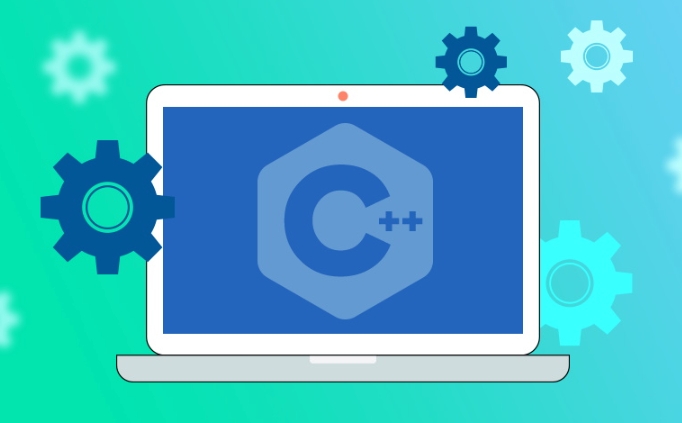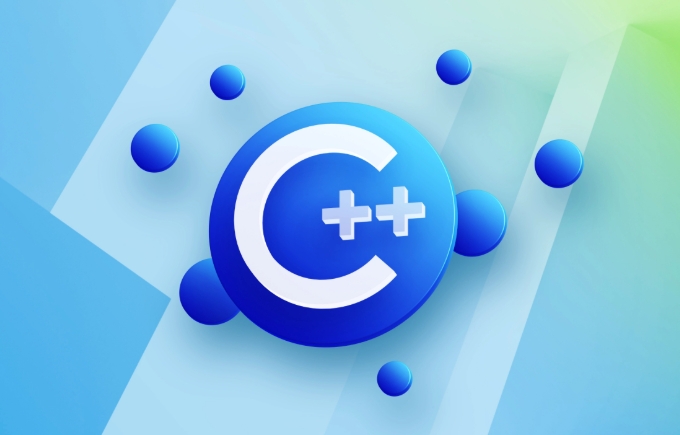What are some good beginner C projects to build a portfolio?
Jul 09, 2025 am 01:57 AMFor beginners who are just starting out with C, it is recommended to start with simple but challenging projects to consolidate skills and demonstrate abilities. 1. Simple calculator: implements basic functions such as addition, subtraction, multiplication and division, and can advanced support for bracket analysis, floating point number calculation and error processing, and try to separate logic and interaction to improve the code structure; 2. File management or text processing tools: such as counting the number of characters and words in text, implementing the search and replacement function, and be familiar with file flow and STL containers; 3. Simple database or student management system: Practice object-oriented programming, use class encapsulation information, realize the addition, deletion, modification and query of data, and try to simulate table connections; 4. Mini game development: such as guessing numbers, tic toe, Tetris, etc., exercise logical thinking and state management capabilities, and frequently use loops, judgments and data structures. These projects can be gradually deepened according to interests and progress, focusing on quality rather than quantity, which truly reflects the understanding and hands-on ability of C.

If you are just starting to learn C and want to consolidate your skills and demonstrate your abilities through projects, it is best to start with a simple but challenging small project. These projects do not need to be too complex, but they must reflect your understanding of language and problem-solving skills. Below are some C project suggestions for beginners, which can be practiced and conveniently placed into the portfolio.

1. Simple Calculator
This is one of the most classic introductory projects, but don't underestimate it. A well-made calculator can show you how to master the basic concepts such as functions, classes, exception handling, etc.

- Basic addition, subtraction, multiplication and division functions can be realized first
- Advanced: Added bracket analysis, support for floating point numbers, and error input processing
- If you want to make the interface more friendly, you can use the command line menu or try a simple graphical interface library (such as SFML)
Tips: Try to write the operation logic and user interaction parts separately, so that the code structure will be clearer and easier to expand.
2. File manager or text processing tool
C is very suitable for system-level operations, such as reading and writing files, statistics content, replacing keywords, etc. You can do one:

- Text file content statistician (statistic number of characters, word number, line number)
- File content search and replacement tools
- Simple log analyzer (such as extracting content from specific keywords)
Projects in this direction can familiarize you with file streams (fstream), string processing, and some practical STL containers (such as maps and vectors).
3. Simple database or student management system
This type of project can help you practice object-oriented programming (OOP), such as using features such as classes, objects, and inheritance.
- Functions include adding records, querying, modifying, and deleting data
- Data can be saved in memory or written to files
- Use classes to encapsulate information about "student" or "products"
Want to improve further? You can try to simulate table joins using structures or class combinations, such as establishing associations between a course class and a student class.
4. Mini games: guess numbers, tic toe, Tetris, etc.
Game development is a very interesting direction and can also exercise your logical thinking and state management skills.
- Number guessing game: randomly generate a number, let the user guess, and give a prompt
- Console version of tic toe chess: Two people take turns to play chess to determine the outcome
- A more advanced one can try the console version of Snake or Tetris
This type of project will allow you to frequently use loops, conditional judgments, arrays/vectors, etc., and is a good opportunity for comprehensive training.
In fact, you don’t have to pursue coolness from the beginning when choosing a project. The key is that it can reflect your understanding of C and hands-on ability. The above projects can be gradually deepened according to your own interests and learning progress.
Basically, it’s all. Pick one or two and finish it carefully, which is more valuable than just making tens of them with a simple taste.
The above is the detailed content of What are some good beginner C projects to build a portfolio?. For more information, please follow other related articles on the PHP Chinese website!

Hot AI Tools

Undress AI Tool
Undress images for free

Undresser.AI Undress
AI-powered app for creating realistic nude photos

AI Clothes Remover
Online AI tool for removing clothes from photos.

Clothoff.io
AI clothes remover

Video Face Swap
Swap faces in any video effortlessly with our completely free AI face swap tool!

Hot Article

Hot Tools

Notepad++7.3.1
Easy-to-use and free code editor

SublimeText3 Chinese version
Chinese version, very easy to use

Zend Studio 13.0.1
Powerful PHP integrated development environment

Dreamweaver CS6
Visual web development tools

SublimeText3 Mac version
God-level code editing software (SublimeText3)

Hot Topics
 Using std::chrono in C
Jul 15, 2025 am 01:30 AM
Using std::chrono in C
Jul 15, 2025 am 01:30 AM
std::chrono is used in C to process time, including obtaining the current time, measuring execution time, operation time point and duration, and formatting analysis time. 1. Use std::chrono::system_clock::now() to obtain the current time, which can be converted into a readable string, but the system clock may not be monotonous; 2. Use std::chrono::steady_clock to measure the execution time to ensure monotony, and convert it into milliseconds, seconds and other units through duration_cast; 3. Time point (time_point) and duration (duration) can be interoperable, but attention should be paid to unit compatibility and clock epoch (epoch)
 What is the volatile keyword in C ?
Jul 04, 2025 am 01:09 AM
What is the volatile keyword in C ?
Jul 04, 2025 am 01:09 AM
volatile tells the compiler that the value of the variable may change at any time, preventing the compiler from optimizing access. 1. Used for hardware registers, signal handlers, or shared variables between threads (but modern C recommends std::atomic). 2. Each access is directly read and write memory instead of cached to registers. 3. It does not provide atomicity or thread safety, and only ensures that the compiler does not optimize read and write. 4. Constantly, the two are sometimes used in combination to represent read-only but externally modifyable variables. 5. It cannot replace mutexes or atomic operations, and excessive use will affect performance.
 How to get a stack trace in C ?
Jul 07, 2025 am 01:41 AM
How to get a stack trace in C ?
Jul 07, 2025 am 01:41 AM
There are mainly the following methods to obtain stack traces in C: 1. Use backtrace and backtrace_symbols functions on Linux platform. By including obtaining the call stack and printing symbol information, the -rdynamic parameter needs to be added when compiling; 2. Use CaptureStackBackTrace function on Windows platform, and you need to link DbgHelp.lib and rely on PDB file to parse the function name; 3. Use third-party libraries such as GoogleBreakpad or Boost.Stacktrace to cross-platform and simplify stack capture operations; 4. In exception handling, combine the above methods to automatically output stack information in catch blocks
 What is a POD (Plain Old Data) type in C ?
Jul 12, 2025 am 02:15 AM
What is a POD (Plain Old Data) type in C ?
Jul 12, 2025 am 02:15 AM
In C, the POD (PlainOldData) type refers to a type with a simple structure and compatible with C language data processing. It needs to meet two conditions: it has ordinary copy semantics, which can be copied by memcpy; it has a standard layout and the memory structure is predictable. Specific requirements include: all non-static members are public, no user-defined constructors or destructors, no virtual functions or base classes, and all non-static members themselves are PODs. For example structPoint{intx;inty;} is POD. Its uses include binary I/O, C interoperability, performance optimization, etc. You can check whether the type is POD through std::is_pod, but it is recommended to use std::is_trivia after C 11.
 How to call Python from C ?
Jul 08, 2025 am 12:40 AM
How to call Python from C ?
Jul 08, 2025 am 12:40 AM
To call Python code in C, you must first initialize the interpreter, and then you can achieve interaction by executing strings, files, or calling specific functions. 1. Initialize the interpreter with Py_Initialize() and close it with Py_Finalize(); 2. Execute string code or PyRun_SimpleFile with PyRun_SimpleFile; 3. Import modules through PyImport_ImportModule, get the function through PyObject_GetAttrString, construct parameters of Py_BuildValue, call the function and process return
 What is function hiding in C ?
Jul 05, 2025 am 01:44 AM
What is function hiding in C ?
Jul 05, 2025 am 01:44 AM
FunctionhidinginC occurswhenaderivedclassdefinesafunctionwiththesamenameasabaseclassfunction,makingthebaseversioninaccessiblethroughthederivedclass.Thishappenswhenthebasefunctionisn’tvirtualorsignaturesdon’tmatchforoverriding,andnousingdeclarationis
 What is a null pointer in C ?
Jul 09, 2025 am 02:38 AM
What is a null pointer in C ?
Jul 09, 2025 am 02:38 AM
AnullpointerinC isaspecialvalueindicatingthatapointerdoesnotpointtoanyvalidmemorylocation,anditisusedtosafelymanageandcheckpointersbeforedereferencing.1.BeforeC 11,0orNULLwasused,butnownullptrispreferredforclarityandtypesafety.2.Usingnullpointershe
 How to pass a function as a parameter in C ?
Jul 12, 2025 am 01:34 AM
How to pass a function as a parameter in C ?
Jul 12, 2025 am 01:34 AM
In C, there are three main ways to pass functions as parameters: using function pointers, std::function and Lambda expressions, and template generics. 1. Function pointers are the most basic method, suitable for simple scenarios or C interface compatible, but poor readability; 2. Std::function combined with Lambda expressions is a recommended method in modern C, supporting a variety of callable objects and being type-safe; 3. Template generic methods are the most flexible, suitable for library code or general logic, but may increase the compilation time and code volume. Lambdas that capture the context must be passed through std::function or template and cannot be converted directly into function pointers.






